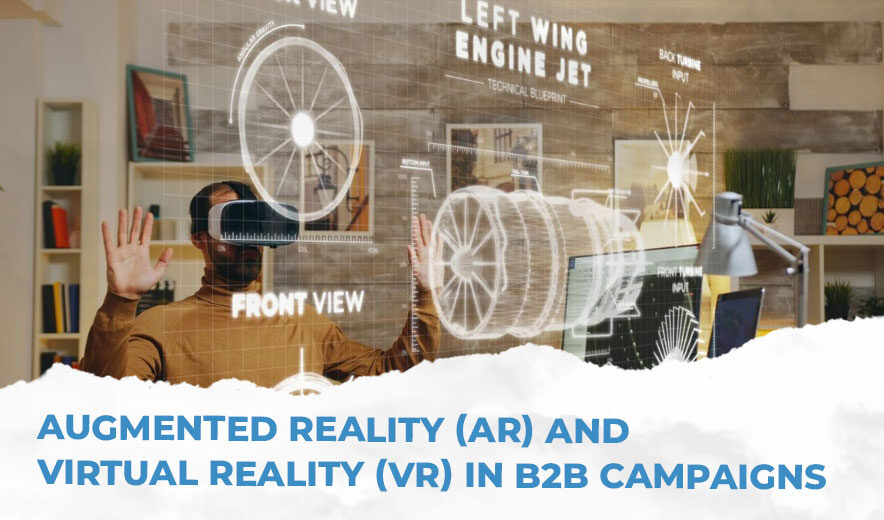Augmented Reality (AR) and Virtual Reality (VR) in B2B Campaigns
In recent years, there’s been a notable increase in the use of augmented reality (AR) and virtual reality (VR) technologies across different industries, including business-to-business (B2B) marketing. These emerging technologies are changing how companies interact with their target audience, improve operations, and boost sales. Let’s explore the growing adoption rate of AR and VR in B2B campaigns and their impact on the marketing landscape.
Introduction to AR and VR in B2B Campaigns
Augmented reality (AR) overlays digital content in the real world, enhancing how users see their surroundings. Virtual reality (VR), on the other hand, immerses users in a computer-generated simulated environment. Both AR and VR present distinct opportunities for B2B marketers to craft compelling campaigns that connect with their audience.
Understanding Augmented Reality (AR)
Definition and Basics
Augmented Reality (AR) technology blends digital content like images, videos, or 3D models with the real world, usually via a smartphone, tablet, or wearable device. This enables users to engage with virtual elements while staying connected to their surroundings.
Applications in B2B Marketing
In B2B marketing, AR can provide interactive product demonstrations, allowing potential clients to visualize and interact with products in real-time. Additionally, AR-powered apps can offer immersive training experiences, enabling employees to learn new skills or procedures in a simulated environment.
Exploring Virtual Reality (VR)
Definition and Basics
VR technology creates a fully immersive digital environment allowing users to explore and interact through specialized headsets or goggles. . This technology offers a sense of presence and immersion by replacing the real world with a computer-generated environment, effectively blocking out the physical surroundings.
Utilization in B2B Campaigns
B2B marketers leverage VR to create immersive experiences such as virtual product tours, trade show simulations, and remote collaboration environments. VR helps businesses showcase their offerings uniquely, capturing potential clients’ attention effectively.
Advantages of Implementing AR and VR in B2B Marketing
Enhanced Product Demonstrations
AR and VR technologies enable businesses to offer interactive and engaging product demonstrations. This enables potential clients to experience products in a realistic virtual environment.
Improved Customer Engagement
By providing immersive experiences, AR and VR can captivate audiences and drive higher levels of engagement compared to traditional marketing methods.
Cost Savings in Training and Prototyping
VR-based training programs offer a cost-effective alternative to traditional training methods by minimizing expenses like travel and equipment maintenance. Additionally, virtual prototyping allows companies to test product designs and concepts more efficiently, saving time and resources.
Challenges and Solutions
Technical Constraints
One of the main challenges in implementing AR and VR technologies is ensuring compatibility across various devices and platforms. However, technological advancements and standardized development frameworks are helping to address these issues.
Adoption Hurdles
Some businesses may be hesitant to adopt AR and VR due to concerns about cost, complexity, or lack of expertise. Educating stakeholders about the potential benefits and offering tailored solutions can help overcome these barriers.
Addressing Security Concerns
When using AR and VR solutions, ensuring security and privacy is crucial. Companies need to prioritize protecting data and put strong security measures in place to safeguard sensitive information.
Future Trends and Predictions
Augmented Reality (AR) and Virtual Reality (VR) are set to revolutionize B2B marketing shortly, offering immersive experiences that drive customer engagement and boost sales. A key trend on the horizon is the utilization of AR and VR for improved product demonstrations.
These technologies will enable B2B marketers to showcase their products in virtual environments, allowing potential buyers to interact with them in previously impossible ways. This immersive experience will help prospects better understand the value proposition of the products and make more informed purchasing decisions.
Conclusion
In conclusion, the accelerated use of augmented reality (AR) and virtual reality (VR) in B2B campaigns is transforming how businesses market their products and services. Leveraging these immersive technologies enables companies to create memorable experiences, drive customer engagement, and gain a competitive edge in the market.
If you want to know more or need help with zero-party data, Marrina Decisions is here to assist you. You can easily reach out to us by visiting our Contact Us page, emailing us at info@marrinadecisions.com, or connecting with us on Facebook, Twitter, or LinkedIn.
For more of our insightful blogs, click here.

